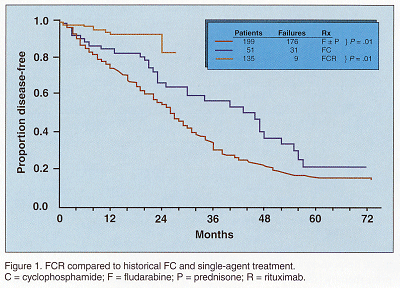Adding Rituximab to Fludarabine and Cyclophosphamide Boosts Efficacy Against CLL
HOUSTON-The combination of fludarabine (Fludara) and cyclophosphamide (Cytoxan, Neosar) plus rituximab (Rituxan), known as FCR, produces "a higher complete remission rate than prior regimens tested" against chronic lymphocytic leukemia (CLL), reported William Wierda, MD, of the department of leukemia at The University of Texas M. D. Anderson Cancer Center in Houston. In addition, molecular remissions can be demonstrated in a significant number of those responding to the FCR combination.
HOUSTONThe combination of fludarabine (Fludara) and cyclophosphamide (Cytoxan, Neosar) plus rituximab (Rituxan), known as FCR, produces "a higher complete remission rate than prior regimens tested" against chronic lymphocytic leukemia (CLL), reported William Wierda, MD, of the department of leukemia at The University of Texas M. D. Anderson Cancer Center in Houston. In addition, molecular remissions can be demonstrated in a significant number of those responding to the FCR combination.
Among a group of 135 patients receiving six cycles of FCR, 63% of the patients achieved complete remission and the overall response was 95%. To determine the level of molecular remission, polymerase chain reaction (PCR) assay was performed on the bone marrow of 55 of the 85 patients achieving complete remission, and 56% were negative. Negativity was also demonstrated in the bone marrow of 6 out of 10 partial responders assayed (out of a total of 23). Five of those six patients were in partial remission due to anemia or low platelet or neutrophil counts, and "none of the five had morphologic evidence of residual disease," Dr. Wierda reported.
PCR was performed on both blood and marrow on some patients achieving complete or partial remission. "There was a strong correlation between blood and marrow," Dr. Wierda said, "and the discordance rate was less than 10%."
Updated Data Presented
"The increased activity of fludarabine combined with cyclosphosphamide, and the potential for chemosensitization between purine analogs, alkylating agents, and monoclonal antibodies, is the rationale for combining these agents in a trial to determine the efficacy." Dr. Wierda explained.
Data presented on the FCR study last year included only 53 patients, while the updated data include 135 patients. All were "required to have an indication for treatment according to National Cancer Institute working group criteria," Dr. Wierda said. In addition, patients could have had no prior therapy for CLL, a performance status of 3 or less, and adequate hepatic and renal function.
Six cycles of FCR were administered. In the first cycle, patients received rituximab at the standard dose of 375 mg/m² on day 1. In subsequent cycles, rituximab was administered at the higher dose of 500 mg/m² on day 1. Fludarabine at 25 mg/m² and cyclophosphamide at 250 mg/m² were given on days 2 to 4 of cycle 1 and days 1 to 3 of cycles 2 to 6.
The overall response rate for the 135 patients was 95%, including 63% complete response. There were "two early deaths, both related to infection," Dr. Wierda said. An analysis of response by pretreatment characteristics demonstrated that patients younger than 70, as well as those with early-stage disease, had a higher complete remission rate. Early analysis found that the median time to progression for the 135 patients treated with the FCR regimen was more than 22 months, Dr. Wierda reported (see Figure 1).

Most Completed Cycles
"The FCR regimen was well-tolerated. Nearly three-quarters of patients received all six cycles, compared to one-half of patients receiving six cycles of the FC regimen," Dr. Wierda said.
"Toxicities related to the first dose of rituximab were more frequent and more severe than with subsequent doses. Grade 3 and 4 toxicities were noted in 8% of the patients on their first dose, and the most common reported toxicity was fever and chills," he continued.
"Nausea was the most common toxicity associated with 20% of the cycles and this was similar to that seen in the FC regimen. Grade 3 neutropenia occurred in about one-quarter of the courses and about one-third of patients experienced grade 4 neutropenia. This was higher than that seen in the FC-treated patients," Dr. Wierda said. "Despite this, there was no increase in the number of major infections, including pneumonia and sepsis, nor in the number of minor infections. The number of grade 2 and 4 thrombocytopenia incidents was similar in the two regimens."